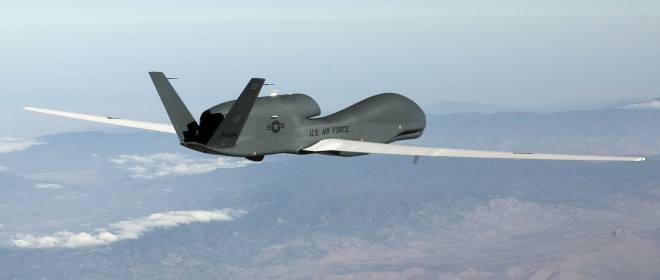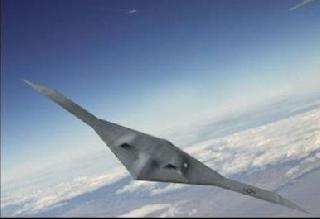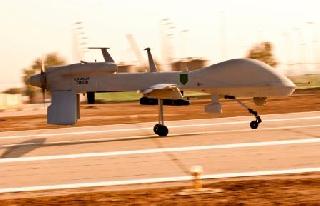China Developing Armed/Recon UAVs
ZHUHAI, China - China is making inroads in the development of armed unmanned aerial vehicles (UAVs), as was evident at last week's 8th China International Aviation and Aerospace Exhibition (2010 Zhuhai Airshow).
The biennial air show and defense exhibition coincided with the release of a critical report on China's military to the U.S. Congress by the U.S.-China Economic and Security Review Commission. The annual report indicates China is developing a "variety of medium- and high-altitude long-endurance" UAVs that will include "options for long-range reconnaissance and strike" missions.
The Zhuhai Airshow provided plenty of examples of China's efforts in developing combat UAVs.
AVIC
The China Aviation Industry Corp. (AVIC) displayed a model of the new Pterodactyl I UAV. Similar in configuration to as the U.S.-built Raptor, the model was equipped with an unidentified air-to-ground missile under each wing. The 9nine-meter-long UAV has a wingspan of 13 meters and a fuselage width of 1 meter. Performance capabilities include a range of 4,000 kilometers, an endurance of 20 hours, maximum speed of 280 kilometers per hour and a maximum altitude of 5,000 meters. It was also outfitted with a sensor turret under the nose.
AVIC also displayed a model of the TL-8 training drone capable of simulating second- and third-generation fighter aircraft and cruise missiles. According to an AVIC brochure, the drone can operate at 0.85 Mach with a maximum flight time of 40 minutes.
The company also displayed models of two short-range fixed winged reconnaissance UAVs - Night Eagle and SW-1. Both have an operational flight time of three hours. AVIC also provided information on the new ducted-fan Whirlwind Scout. Capable of vertical takeoff and landing, the Scout has a 20-40 minute operational endurance.
AVIC also displayed four examples of its YY Series multipurpose electro-optical and multisensor turrets. The stabilized turrets allow for a variety of surveillance and reconnaissance missions, including tracking, identification, observation, range measurement, and aiming and target designation of marine, ground and air targets. The YY Series brochure showed turrets outfitted on two different unidentified UAVs and one manned helicopter.
CASC
The China Aerospace Science and Technology Corp. (CASC) displayed a full-scale model of an armed CH-3 UAV with air-to-ground missiles. The model was also outfitted with a sensor turret. According to a CASC brochure, the multipurpose UAV is capable of battlefield reconnaissance, fire adjustment, data relay, intelligence collection, ground-strike missions and electronic warfare (EW) missions.
"It can be modified as an unmanned attack platform to carry small precision guided weapons for performing reconnaissance/strike missions." The CH-3 has a cruising speed of 220 kilometers per hour, 12-hour maximum endurance and a 200 kilometer communications radius.
A model of the CASC CH-803 multipurpose UAV was also on display. The aircraft can perform battlefield reconnaissance, fire adjustment, intelligence collection and EW. Parameters include a cruising speed of 80-110 kilometers per hour, five-hour endurance and a communications radius of 50 kilometers.
CASC also provided new data on UAV-related products, including the "TH Mini Precise Attack Missile" for air-to-ground strike missions and the new CP-04 motor for the SK-200 turbofan-propelled UAV booster.
The "TH Mini" can be outfitted on light UAVs and be used to target stationary or low-velocity moving ground targets. The missile, armed with a 5-kilogram blast fragmentation warhead, has a maximum range of 3.2 kilometers at 277 meters per second. Guidance modes include an inertial navigation system and charge coupled-device system.
The 13 kilogram CP-04 motor "gives a boost for the UAV during take-off" then separates and falls to the ground. The motor design has been completed and batch production will soon begin, said a CASC brochure.
CASIC
No armed reconnaissance UAV received more attention than the WJ-600. Produced by the China Aerospace Science and Industry Corp. (CASIC), the jet-powered, multimission UAV was shown in a CASIC video locating a U.S. aircraft carrier and sending targeting information for a follow-on anti-ship cruise missile attack.
The WJ-600 can conduct "informationized warfare," said a CASIC display. It can be outfitted with a synthetic aperture radar, electro-optical and multisensor turret, information relay and a variety of weapons. Weapons on display included the air-to-ground KD-2 missile and two weapons with the designation "TBI" and "ZD1," which were not clearly described. Operational parameters were not provided.
Another CASIC UAV on exhibit was a stealthy tailless flying wing configuration, the SH-1. The aircraft, outfitted with a sensor turret, can perform battlefield reconnaissance, target identification and positioning, and "strike effect assessments." The SH-1 appears to be a short-range UAV with limited capabilities, though no operational parameters were provided.
ASN
The largest exhibit of UAVs was by ASN Technology Group, a company solely dedicated to UAV development and production. ASN provided new details about the ASN-229A "Reconnaissance and Precise Attack" UAV. A display of a model of the aircraft indicates it can perform reconnaissance and has a "mini precise guidance weapon system."
However, the maximum mission payload is only 100 kilograms and it is unlikely to be able to carry a weapon. The ASN-229A will have a take-off weight of 800 kilograms and a cruising speed of 160-180 kilometers per hour with an endurance of 20 hours.
http://www.defensenews.com/story.php?i=5101322&c=ASI&s=TOP





















